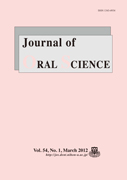Volume 56, Issue 3
September
Displaying 1-10 of 10 articles from this issue
- |<
- <
- 1
- >
- >|
Original
-
2014Volume 56Issue 3 Pages 185-190
Published: 2014
Released on J-STAGE: September 17, 2014
Download PDF (869K) -
2014Volume 56Issue 3 Pages 191-194
Published: 2014
Released on J-STAGE: September 17, 2014
Download PDF (1016K) -
2014Volume 56Issue 3 Pages 195-199
Published: 2014
Released on J-STAGE: September 17, 2014
Download PDF (783K) -
2014Volume 56Issue 3 Pages 201-207
Published: 2014
Released on J-STAGE: September 17, 2014
Download PDF (698K) -
2014Volume 56Issue 3 Pages 209-214
Published: 2014
Released on J-STAGE: September 17, 2014
Download PDF (964K) -
2014Volume 56Issue 3 Pages 215-219
Published: 2014
Released on J-STAGE: September 17, 2014
Download PDF (417K) -
2014Volume 56Issue 3 Pages 221-225
Published: 2014
Released on J-STAGE: September 17, 2014
Download PDF (1002K)
Case Report
-
2014Volume 56Issue 3 Pages 227-230
Published: 2014
Released on J-STAGE: September 17, 2014
Download PDF (944K) -
2014Volume 56Issue 3 Pages 231-234
Published: 2014
Released on J-STAGE: September 17, 2014
Download PDF (577K) -
2014Volume 56Issue 3 Pages 235-238
Published: 2014
Released on J-STAGE: September 17, 2014
Download PDF (479K)
- |<
- <
- 1
- >
- >|
